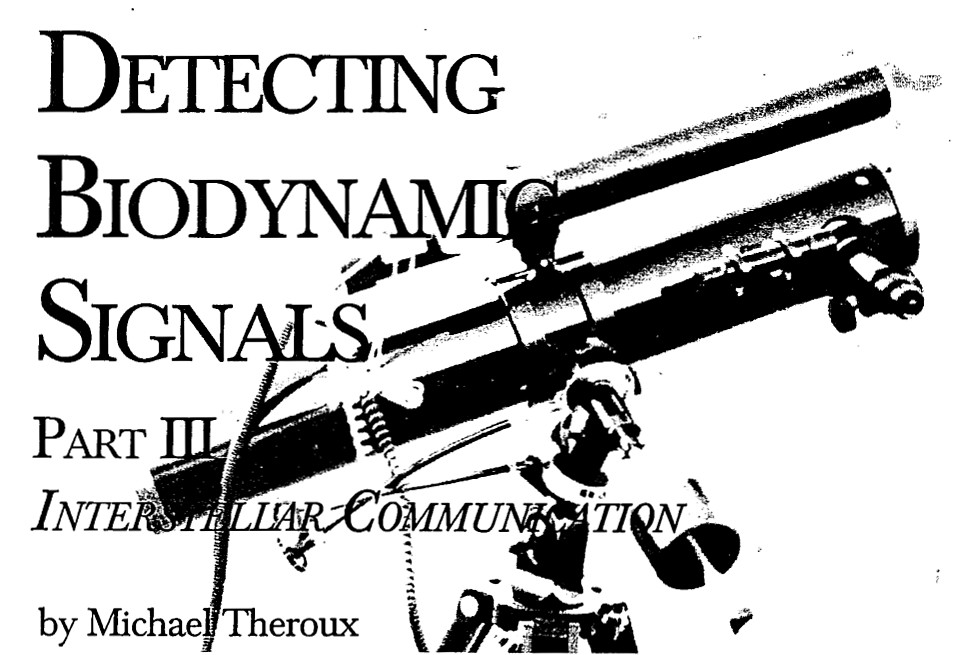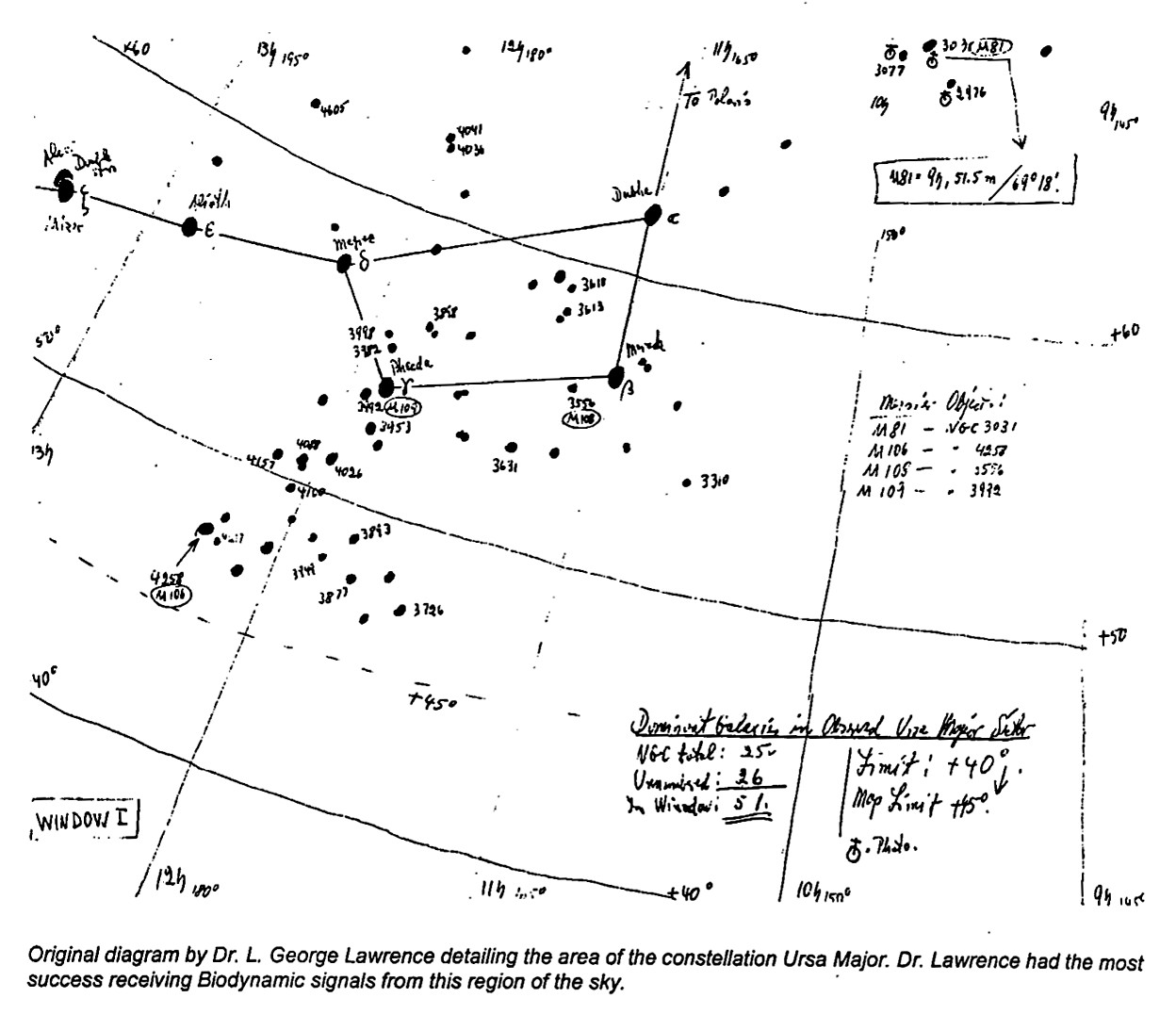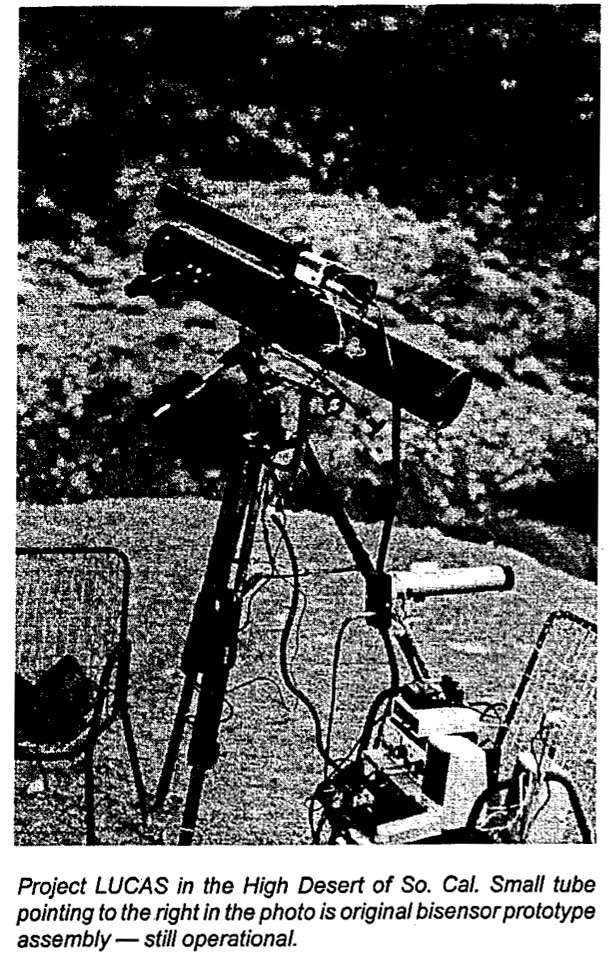
HISTORICALLY, the alleged reception of signals of an extraterrestrial origin dates back to the very beginnings of radio. In fact, we find that the recent history of the investigation into interstellar communications is almost completely restricted to the science of radio astronomy — a technology which is quite limited due to the necessity of obeying the confines of the electromagnetic spectrum. Early in his career, Dr. L. George Lawrence recognized this limitation, and sought to overcome it by introducing a means of communication which was not bound by conventional electromagnetic laws. "Biological" or "Biodynamic" communication, as Lawrence called it, found its medium completely outside of the electromagnetic spectrum, and therefore solved many of the problems facing the prevailing radio-astronomical methodology of interstellar communication. To comprehend the complexity of these problems, we must briefly detail the historical background of conventional interstellar communications (hereinafter referred to as ICOMM).
Radio Astronomy and the Birth of ICOMM
Both Nikola Tesla and Guglielmo Marconi would be remembered for their early pronouncements of receiving "alien" signals (see "Communicating with Mars" on page 33), but it wasn't until 1930 that the birth of radio astronomy and the consequent reception of radio signals of galactic origin heralded the beginnings of ICOMM. Karl Jansky, an American radio engineer, was the first to pinpoint signals originating from the center of the galaxy. We needn't detail his findings here as we have reprinted the entire 1934 document (see "Short-wave Signals from Interstellar Space" on page 38). Shortly after World War II and the development of RADAR, the military began frequently intercepting radio signals originating from outer space. With this development, the first large radio telescopes would be employed for purely scientific purposes.
The first plan to monitor the stars for signs of intelligent life was conducted by Frank Drake, the then Director of the National Radio Astronomy Observatory (NRAO) at Green Bank, West Virginia in 1960. The project was called "Ozma", after the imaginary land of Oz, from L. Frank Baum's Wizard of Oz. The intended targets were Tau Ceti (11.9 light years from earth) and Epsilon Eridani (10.8 light years from earth). After observing for a total time of about 4 weeks in the region of the 21-centimeter hydrogen band, no signals were found. Thus ended Project Ozma — and to this day — no signals have been found by any standard radio-astronomical methods. Many so-called SETI (Search for Extraterrestrial Intelligence) projects, and several millions of dollars in funding later, have turned up [43] nothing. Even NASA showed interest for a while, spending $60-70 million since 1971, but in the early 1990s, they dumped SETI and other projects from their budget.
The SETI institute's latest endeavor, called Project Phoenix, began in February 1995 at the Parkes radio astronomy observatory in New South Wales, Australia. So far, they have managed to bring in more than $7.3 million in private donations for their efforts. State-of-the-art equipment was used to listen to about 200 southern hemisphere stars, scanning 28 million channels simultaneously at single-Hertz resolution using the 64 meter radio telescope. A follow-up telescope located 120 miles away allowed them to distinguish between terrestrial and galactic signals by utilizing Doppler shift. But, still no ET. Promising signals have all turned out to be things such as satellites, military radar, and even TV stations. They haven't given up though, and plan to focus on 900 northern hemisphere stars next.
The Problem with Radio-astronomical ICOMM
The major difficulty with radio-astronomical ICOMM is that at its foundation lies some very uncreative quantitative assumptions. The basis for the entirety of this research assumes that an extraterrestrial civilisation's technology is comparable to, and has evolved to a state equal to our own. Without thought, academia casually presupposes that there are many, "...civilisations intelligent enough to build radio transmitters," and "...several million civilisations matching the Earth's standard of development." Quite an egotistical assumption for a culture that admits no solution to the mysteries of their own ancient civilisations!
Because technology on this planet has evolved in a specific direction (in this case toward the quantitative and mechanistic) does not foreordain that any other civilisation's technological evolution must parallel ours. It is quite possible, and certainly probable that many civilisations of galactic origin may have technologically evolved toward the perceptive and qualitative. These may be the standards by which they seek to communicate, and as we shall see, offer greater success considering the great distances with which ICOMM necessitates.
Language of the Stars
The most difficult obstacle to overcome concerning ICOMM lies with the exchange of information. Since conventional presumption is so anthropomorphically restrained, the academics insist on using our own cultural and societal development as a guide to choosing the proper cosmic linguistic form. Simple messages, binary call signals, pictograms, and even an artificial schematic language called Lincos have been suggested and even transmitted to the stars. But, even simple language can pose incredible difficulty for scholars wishing to make an interpretation. Earlier advanced cultures on our own planet have left us with innumerable writings which still evade academia's decryption. Even the late skeptic and mechanist Carl Sagan foresaw this conundrum: "European scholars spent more than a century in entirely erroneous attempts to decode Egyptian hieroglyphics before the discovery of the Rosetta Stone [1799] and the brilliant attack on its translation by Young and Champollion. Some ancient languages, such as the glyphs of Easter Island, the writings of the Mayas, and some varieties of Cretan script, remain completely undecoded at the present time . . . how can we expect that a civilisation vastly more advanced than we, and based on entirely different biological principles, could ever send a message we could understand?"
Dr. L. George Lawrence was clearly aware of these facts before he began his pioneering efforts in biodynamic ICOMM. Dr. Lawrence proposed that certain advanced civilisations would have developed a means of communication utilising purely biological principles. This biological exchange of information has been previously outlined in parts I and II of this article, which also detail Dr. Lawrence's experiments in biodynamic transfer of information. Dr. Lawrence stated that these galactic cultures may have communicated by a method now lost to our civilisation — eidetic communication — where the biodynamic energy transfer acts as the carrier, and the patternate content is the modulation. This patternate content is the actual [44] eidoform, or complete eidetic picture. What makes this method superior to conventional radio reception is the fact that biodynamic information is transmitted in a longitudinal point-to-point fashion. One doesn't have to wait light years for the reception of a message — it is nearly instantaneous. This may be likened to simple remote viewing, only in this case it is device assisted — ensuring minimal errors. Gerry Vassilatos has done substantial work in this field which he calls Device Assisted Remote Viewing — and with notable success.
Determining the Method of Transmission
Dr. Lawrence was not without his own assumptions concerning the possible methods of galactic transmission. Of course, we have to begin somewhere, and Dr. Lawrence, being a radio engineer, followed the simple progression entailed in sending and receiving conventional radio communications. This follows the Russian theorist Y.I. Kuznetzov's outline of the communication process via the concepts of communication, coding, signal, and modulation. Lawrence's version would be detailed thusly: The communication (Eidogram) would be converted into a form suitable for transmission (biodynamic signal), the coding being the method of conversion, and the modulation (patternate content) would be the change in the parameters of the emission sewing as the carrier of the (biodynamic) signal. For reception, one would simply reverse this process.
Dr. Lawrence arrived at these conclusions based on his qualitative analysis of the sound emitted from his experimental setup. The modulations he heard displayed a character not unlike other conventional transmissions, which led him to work on their immediate conversion to visual images. At the very heart of Dr. Lawrence's system was a unique form of biodynamic transducer which enabled him to receive and transmit signals of a biological origin.
Qualitative to Quantitative Analysis:
Biosensor Technology
and the Biodynamic Transducer
Early in Dr. Lawrence's career, he began work on a series of transducers of biodynamic energy. In order to utilise quantitative measuring instruments, biodynamic energy would need to be converted or transduced into electrical energy. Initial experiments commenced with simple Wheatstone bridge circuits and plant material as the biosensor. Although the plant material reacted to biodynamic stimuli such as touch, and even directed thought, this was found to be unwieldy as the plant material was possessive of its own consciousness. It could easily become fatigued and stressed, or would simply seem unconcerned when experimental matters were conducted. Dr. Lawrence then began a systematic search of the organic semiconductor library for an answer. He found that a simple mixture of protein complexes, a sort of primeval soup as it were, produced remarkable results. But, the problem of tuning to specific biodynamic energies still existed. One needed to capture individual responses to particular stimuli in order to rule out any possibility of unwanted artifact. This necessitated the addition of special substances to the soup, to be used as what Lawrence termed the "excitation" mixture. These ranged from organo-methylglyoxol compounds to a variety of mineral compositions — each with their individual response characteristics. Now, the qualitative reactions of this biological "soup" could be directly transduced into a quantitative electrical signal via the use of high impedance amplifiers, and when mixed with a local oscillator, produced the desired output signal for analysis.

Project LUCAS
Project LUCAS, named after Dr. L. George Lawrence, was designed with the intention of re-creating these biodynamic interstellar communications experiments. Myself and researcher Michael Elsey journeyed to the High Desert area of the Joshua Tree National Monument for the re-creation. Many months of preparation preceded the actual experiments — the fabrication of biosensors and electronic equipment, laboratory testing, and experiment rehearsal. The project has been largely unfunded, [45] and the total cost of the present experimental setup is under $1000.

We began the experiment with a horizon-to-horizon scan of the sky to see if there was any indication of biodynamic signals present. It was immediately discovered that one of the newly constructed pieces of equipment, the actual electronic sensing apparatus, suffered from electromagnetic interference, and had to be removed from the experiment. An older unit was inserted in its place and performed to our expectations with no interference problems. Our initial targets would be two galaxies in the Ursa Major constellation: M81 and M82. These were chosen because of all the searches conducted, Dr. Lawrence had the greatest success there. Our horizon-to-horizon scanning continued slowly to ensure proper functioning of the equipment, and eventually would focus in on the target area. Our first pass at M81 revealed nothing. I was concerned that the older equipment wasn't sensitive enough and I began tuning knobs. Nothing happened. As we settled into the campsite, we decided to leave the telescope and biosensor focused in on the target area for awhile. I remembered Dr. Lawrence's notes regarding how several weeks would go by without the detection of any signal, but I was still becoming somewhat discouraged and impatient by the lack of reception of signals, and continued to believe the equipment may be to blame. Suddenly, bursts of modulation poured out of the speakers. I immediately checked the equipment to make sure there wasn't a malfunction. Everything was in order. The bursts lasted only about ten seconds, and then as if nothing had happened, the equipment returned to the idle state. This would happen one more time the entire evening. Both instances were captured to cassette tape for further analysis.
We feel confident that this project confirmed Dr. Lawrence findings. There is no doubt that some kind of biodynamic signal [46] was received from the direction of the constellation Ursa Major. Ideally, a remote biodynamic station would be set up to monitor this area on a continuing basis so more information could be obtained and analysed. We may return to the problem of interpretation of these signals at a later time, but for now, the reception of biodynamic information from space has once again been verified.
Conclusion
Hopefully, there will be enough interest and time to continue in this experimental direction. The need for better equipment, and constant monitoring are essential to such a project, but without proper funding, may be delayed for several years. Still, we continue experimentation on the transfer of biological information, and are now working toward development of simple practical applications of this technology. Working outside of the electromagnetic spectrum into the domain of biological energies opens up a vast new area of research far exceeding the singular employment of interstellar communications. Technologies which could arise from this pursuit are manifold, and applications such as point-to-point terrestrial communications, and portable biodynamic detectors may be a part of the near future.
References
- Galactic Life Unveiled - The Phenomenon of Biological Communication Between Advanced Life in Space and Its Subliminal Effects on Terrestrial Man, by L. George Lawrence. Borderlands, 1997. [Now available in our standard xerographic format: <#B0388, "Galactic Life Unveiled">]
- "Methods and Receiver for Biological Data Transport," L. George Lawrence. Abandoned patent, 1981.
- "Interstellar Communication," L. George Lawrence, Electronics World, N.Y., 86:4, October, 1971, pp.34—45, ff. <Full-text>
- "New Worlds Revealed by Living Transducers," L. George Lawrence, Electrical Review, London, June 2, 1972.
- "Biological Signals from Outer Space," L. George Lawrence, Human Dimensions, HD Institute, Buffalo, 2.2, Summer, 1973, pp. 16-18.
- "Cinema 2000: The Quest for Extraterrestrial Video," L. George Lawrence, Electronics and Technology Today, March-April 1992.
- "Interstellar Communications Signals," L. George Lawrence, Ecola Institute Bulletin #72/6A, Reprinted in Journal of Borderland Research, Vol. 29, No. 4 (July-Aug 1973). <Full-text>
- "Are We Receiving Biological Signals from Outer Space?," L. George Lawrence, Popular Electronics, April 1991. <Full-text>
- "The Starland Galactic Transmission Theatre," L. George Lawrence. Unpublished.
- "Biological Image Transmission," L. George Lawrence, 1989. Unpublished.
- Contact with the Stars, Reinhard Breuer, Oxford, S.F., 1982. <>
- "The Galactic Gamble - SETI Researchers Boldly Comb the Cosmos for Stellar Radio Stations," Michael Mechanic, Popular Communications, March, 1997.
- Messages From the Stars, Ian Ridpath, Harper & Row, 1978. <>
- The Search for Life on Other Worlds, Captain David C. Holmes, USN, Bantam, 1967. <>
- Is Anyone Out There?, Jack Stoneley with A.T. Walton, Warner, 1974. <>
- Intelligent Life in the Universe, I.S. Shklovskii and Carl Sagan, Delta, 1968. <>
- We are Not Alone, Walter Sullivan, McGraw-Hill, 1964. <>
- Charge and Field Effects in Biosystems, by W.J. Aston, Abacus Press, Turnbridge, UK 1984, pp. 491-498. <>
- Electrophysiological Methods in Biological Research, by J. Bures, Academic Press, N.Y., 1967. <>
- Organic Semiconductors, by F. Gutmann and L.E. Lyons, Wiley, N.Y., 1967. <>
- "Biosensors" by C.R. Lowe, Trends in Biotechnology, Elsevier, Amsterdam, 2:3, 1984, pp. 59-65.
- Biosensors: Fundamentals and Applications, by A.F.P. Turner, Oxford Univ. Press, Oxford, UK, 1987. <>
